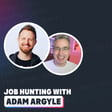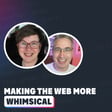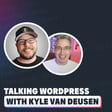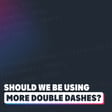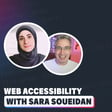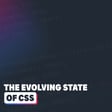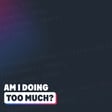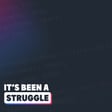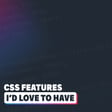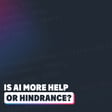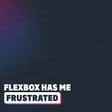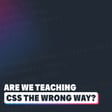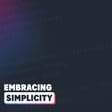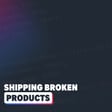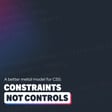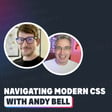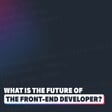Become a Creator today!Start creating today - Share your story with the world!
Start for free
00:00:00
00:00:01

Navigating Accessibility Challenges in Web Development
The interview with Salma: https://youtu.be/QYkjgd6_s4o
Practical Accessibility: https://practical-accessibility.today/
In this episode, I discuss the challenges and importance of accessibility in web development, drawing from a personal conversation with Salma Alam-Naylor. O emphasize the need for firsthand experience in advocating for accessibility, the complexities involved in making websites accessible, and practical steps developers can take to improve accessibility. I also highlight the importance of feedback and education in creating inclusive digital experiences.
Transcript
Introduction to Accessibility in Front-End Development
00:00:00
Speaker
Hello my front-end friends, and welcome to my podcast, Journal Musings. My name is Kevin, and in this podcast I talk about whatever is front of mind for me in any given week, usually in some way that's related to front-end development, and this week we're going to be talking about accessibility, but in a bit of a different way than I normally do.
Interview with Salma Alam-Naylor on Accessibility
00:00:16
Speaker
Before we get to what I mean by that, I want to let you know that on my main YouTube channel, I recently put out an interview with Sama Alam Naylor, who you might also know is White Panther over on Twitch. And that's actually the reason that accessibility is front of mind for me, ah because
00:00:33
Speaker
in that conversation or the reason we had that conversation is because she recently developed really bad pain and pins and needles in her hands and her wrists and it made it really difficult for her to type and use a trackpad. And so she joined me to talk about the struggles that she's been going through and some of the tools she's been using and all of that. And it really has been a struggle if you haven't seen her on her streams, especially in the very the first few days was a big learning curve as she was talking about and ah very overwhelming and ah one of the streams she mentions this in the interview that she ended up crying on stream ah just with the being overwhelmed by everything and how difficult it was just to do really simple tasks
00:01:19
Speaker
and she actually said that I could use the clip from that Twitch stream ah within the interview when she mentioned that ah she broke down and and editing that was really hard because I kept shortening it down ah just to try and get it to be the right length for inserting into a bigger conversation. At first it was like three minutes long and it I thought it was really impactful, but I think a lot of people wouldn't want to sit through it all necessarily. um But yeah, every time I went through and was editing it, I was trying not to cry myself. It was just really heartbreaking to watch it.
Challenges and Advocacy in Accessibility
00:01:52
Speaker
uh and this isn't what i want to be talking about today necessarily but just yeah it was it's one of those things that you can definitely imagine could be insanely hard to try and get through and go through um but one of the the reason that i'm talking about it today is because also during that conversation Salma brought up how she's always advocated for accessibility and ah She also mentioned that she knows I do as well, but how, and from that, it sort of came up how for the two of us, now she she's has a a bit more of or a lot more firsthand experience with it, but for the two of us for for so long, while we're advocating for doing things the right way, it can be really hard when we don't have that experience ourselves. And I struggle with this a lot because I want to advocate for doing things
00:02:46
Speaker
the right way as much as possible. And sometimes that's really easy, right? like Keep your focus styles or make sure you have like make sure you're not removing your focus rings, I should say, and or have some sort of focus state on things so you can keyboard navigate. And and there's other things as well. But there's a lot of low hanging fruit that I'm very comfortable talking about. But it's when you start getting into the the deeper world of doing things the right way. It can be really hard to get the right perspective or not get the right perspective, but to know what you're actually trying to achieve because you might think this is what I want it to do.
Creating Accessible Tabs and User Testing
00:03:23
Speaker
only to find out later that somebody who's using some sort of tools to use your website in a different way, it just doesn't that's not how they want it to work type of thing. And even I've had the experience where I did a video on creating accessible tabs and I really wasn't confident in that. So I made my first draft of it.
00:03:43
Speaker
And then I ended up hiring, I worked with Hayden Pickering and a company and I forget, or it was a woman who works at an accessibility company and I forget her name, so I apologize. ah But I had them both look through it and give me feedback on it. And it was really enlightening because my first draft, I was just using the W3C's accessibility initiative. They have really good docs on building out accessible things.
00:04:11
Speaker
And so I more or less got everything, I used everything from that to build out my tab system and then had feedback from the two of them and there was changes to be made. And like Hayden, for example, he it was in I don't remember exactly what it was that he shared, but he's done he was he worked for the BBC and he's done a lot of just accessibility work in general and had the advantage of the work that he would do. They were able to hire people to test these experiences out that had different disabilities. So he would build it, have all the testing done, and then make changes according to the feedback you'd get.
Incorporating Feedback and Hiring Practices
00:04:52
Speaker
which meant or which means he has a wide range of ideas on how the assistive technologies work and how people use the assistive technologies coming from a range of different disabilities, not just focused on one thing necessarily. And so there was a lot of changes we made to take that into account of like, this is what the expected behavior would be for this or this. and I don't remember everything top of mind now because it's been a little while, but just like these small tweaks or small changes or so one of them was even like this.
00:05:21
Speaker
area thing that should work exactly how you were intending it to just doesn't actually like none of the assistive technologies actually use that, ah even though it's there for them. So you're like, Oh, that sucks. So how do you do it instead? And you know, we've we got there in the end. So I'll put a link to that video if you're interested in it. um So you can see, see what I'm talking about there, because again, ah not the greatest description I'm giving right now. So if you're interested in it, ah you can check out the full video.
00:05:49
Speaker
ah But it leads to this idea that accessibility is hard, right? We are making a website properly accessible. It can be really hard and it can feel like diving into the world of accessibility can feel inaccessible, I think, to a certain extent, when we're just overwhelmed by all of the information that's there at once. And I think ah Selma actually highlighted this also during our conversation, that it's really, it it highlights the importance of companies hiring engineers who have disabilities.
00:06:22
Speaker
because that gives that extra perspective from someone who's actually on the team building out the product or the website rather than having to rely on bug reports or people outside of your company telling you about it after the fact that things shipped already. And now you're like, oh, we have these problems that we need to fix. So in other words, there's a whole bunch of technical debt. And then are those actually going to get fixed? Who knows? Right.
00:06:45
Speaker
I realize not everyone listening to this can just go in a hiring spree right now to to to deal with that, but I do think that in an ideal world that would be the best case. Obviously talking to people and asking for feedback on the way interactions are done, because it's mostly about how we interact with these different things, right?
00:07:07
Speaker
And so trying to get feedback on that obviously is a good thing. But even that, depending on your role or just your your audience or whatever it is, your your social circles, it can be hard to get the feedback that you're after. And so I do think that sometimes it becomes a, well, if I can't do it, I'm just not going to bother.
00:07:28
Speaker
And that's the wrong approach as well, right? So I look at how I'm doing it where I try my absolute best and I try to ask for feedback as much as I can. And if I find out, oh, I talked about something in a video that, yeah, maybe it's the right direction, but it's not quite right in the future, I'm definitely going to improve it. And that's what most accessibility people will say is like, do the low hanging fruit stuff, do the easy stuff. And I'll talk more about that in a second if you don't know what I mean by the low hanging fruit. um But do what you can. And then when you find out other things and you learn something new, just integrate that as well and continue just sort of pushing things in the right direction.
Practical Accessibility Tips
00:08:08
Speaker
Because getting everything 100% right might, you know, mean if that could be out of touch, but just because you can't get to 100% doesn't mean you shouldn't try at all. And that you hear about that in companies and stuff all the time, right? Like, oh, we don't want to invest the time or the money we just need to ship. And I realize there's deadlines and you have a sprint and you need to get the door as well. And there's pressure on you. So diving into a whole bunch of docs on how ARIA works might not be something you even have time to do to get your feature out because you need to keep your job. If you're like, oh, i had this is going to take me three sprints to do instead because I'm going to build it out properly, they're just goingnna they they won't
00:08:47
Speaker
ah accept that as an answer. So I realize that's the reality of things. um But I think if you're just focusing, especially on the low hanging fruit, is so much of the big picture of things, which is just things like, you know, I mentioned it before, having ah focus for keyboard navigation. So don't do an outline of none. Find other ways of doing it. If there's someone who's like, Oh, I don't like the focus on that button. When I click on it, use focus visible instead, it'll probably I think focus visible would handle all the cases where somebody's like, oh, why do we have focus on this thing that shouldn't have it because they're clicking on it with their mouse and it doesn't really make sense in that context. So focus visible fixes that ah things like.
00:09:27
Speaker
Making sure your tab order makes sense isn't that hard. Don't throw tab indexes on things just for the fun of it. right and Or if you might want it to go somewhere, but like does it disrupt the flow of everything? And is it macking mucking things up by making those changes? Using links for links, buttons for buttons. This is another one that People get wrong for some reason, and I don't find it that hard, but you know doing that. ah Color contrast, making sure that's sufficient. That one can be a little bit tricky though, because you might be getting designs from the design team. So maybe that actually ends up being a conversation that has to happen. So while it should be really easy, maybe it's a little bit harder, but it's super easy to test. If you're DevTools, you can use, and actually that's a really good one, if there is an issue to start a conversation, because you can just run it through Lighthouse, which will flag contrast issues.
00:10:17
Speaker
And there's like empirical numbers, like you just print it out or print it, take a screenshot and email it ah to to whoever. Because a lot of times those lighthouse numbers, people want good scores on those, um depending on on the company culture and everything else. But yeah, that can be one that can initiate a conversation if there's low contrast ratios. And there's good basic accessibility testing in Lighthouse 2 for things like do ah links have text in them or is it just an icon? If it is just an icon,
00:10:46
Speaker
you know there' There's ways of dealing with that, and they're all things that it's not um more work to do. Some like complex interactions can get more difficult, but so many of the simple things just get overlooked.
00:11:03
Speaker
that And they don't require extra effort, like 30 seconds to to do something instead of 25 seconds. And you've done it, right? And just also thinking about the different ways someone might interact with something is you're using a mouse. The next person's using a touch device. The next person's using a keyboard. The next person after that might be using their voice. So just thinking, like, how is this going to work depending on, and test it, you know, tab through your site, make sure it works that way.
00:11:28
Speaker
There's really simple ways to to test these things out and at a basic level that might not account for every possible situation that's out there, but they do ah accommodate or accommodate might not be the right word, but they'll take like the 80% or up to 90% just
Recommended Resources and Upcoming Interviews
00:11:47
Speaker
by doing that. And then it starts getting into the weeds and it starts getting more complicated.
00:11:51
Speaker
And if you do if you do want to get into the weeds and and into the world of accessibility a little bit more, I would actually recommend Sarah Suedein's course, and Practical Accessibility. It's really, really good. This isn't sponsored in any way. I i grabbed it when before she'd even released it when it was like the the early release, whatever, because I knew I'd want it. And it's a fantastic course. It goes through A lot of things and that would actually be a really good one if you are working somewhere and they probably have some sort of educational budgets like ask your boss or your manager if they'd be willing to pay for it. It's the type of thing that companies should be willing to pay for. Like that's the course the or the style of course that companies should be willing to invest in. So always ask and and find out if that's an option um because yeah, it's a really, really good course if you do want to get more into that world.
00:12:39
Speaker
and So yeah, that's sort of what I wanted to talk about today. And we're going to do a really awkward transition now. I need to get like the sound effects to do like the professional podcaster thing, right? When you transition into a new topic. And it's just to say, it's not ah a big thing. It's just a little bit of house cleaning, I guess, here at the end. ah To give a bit of heads up on the next couple of weeks, what's happening with the podcast.
00:13:00
Speaker
because I won't be here alone. You might have noticed there's been more interviews happening here lately and I wanted to make interviews more of a focus of what I was doing with the podcast. Obviously, I had the interview on the main channel with Salma. That's because the main reason I wanted that as a YouTube video was the increased reach that it's going to get.
00:13:19
Speaker
ah because I think that's really important, a topic to get more, as many people listening to as possible. um But next week, I'm going to be chatting with Josh Como. We're going to be talking about teaching CSS, how he got into teaching things in the first place, ah the different things we've learned about CSS by teaching CSS, get into AI as well a little bit and using it as a learning tool and how it's impacting things or not impacting things ah in the ways people have thought that it would and more. So yeah, I think it was a really ah fun conversation. I think you'll enjoy it. And then the week after that, I'm going to be joined by Miriam Suzanne, who's joining me to talk about the spec, getting involved in the CSS Working Group. ah We talked about SaaS and the increasing number of features coming from SaaS into CSS. Is everything going to come or is is there some things that CSS isn't going to touch? ah Which yes, there are. There's a few features that they have no interest in bringing over, which I thought was interesting.
00:14:15
Speaker
um And yeah, it was a fun conversation. Go all the way from like filing bug reports into starting to write specs, which I'm not about to start doing, but I am interested in getting more involved in the working group. So I sort of said, I'll talk to somebody who who knows
Episode Conclusion
00:14:32
Speaker
a lot about it. And so it was a really good conversation there. So that will be the week after that.
00:14:36
Speaker
And with that, thank you so much for listening. And ah yeah, just the links to everything that I talked about, of course, are in the description. And until next time, don't forget to make your corner of the Internet just a little bit more awesome.

